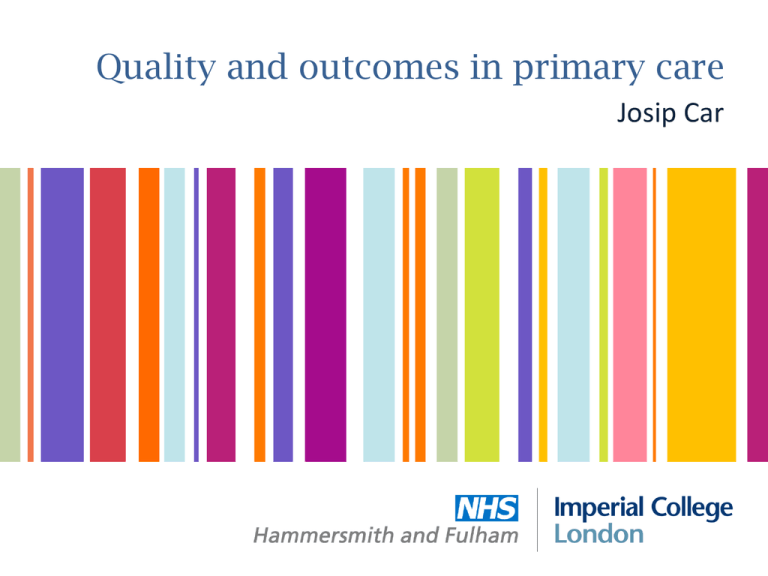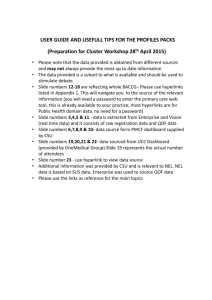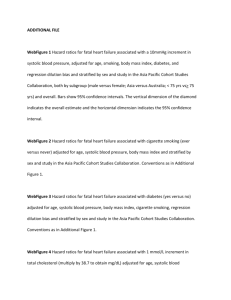1 - Imperial College London
advertisement

Quality and outcomes in primary care Josip Car Quality and outcomes framework (QOF) A national programme for quality improvement in primary care Launched in 2004 as part of the revised GP contract Pay-for-performance 132 chronic disease and administrative targets Quality and outcomes framework (QOF) Concrete evidence of improvement in areas covered by targets with consequential impacts on disease and mortality Campbell et al., 2007; Millett et al., 2008; Millett et al., 2009; Khunti et al., 2007; Mason et al., 2008; Shohet et al., 2007 But... Perpetuating inequalities McLean et al. 2006; Millett et al., 2009 or not? Doran et al., 2008; Millett et al., 2009 , Crawley et al. 2009 Halo effects Campbell et al., 2007; Sutton, 2010 or all-consuming? Steel et al., 2007 Methodological flaws? Guthrie et al., 2006; McLean et al. 2006 Too easy? Fleetcroft et al., 2008 The wrong focus? Darzi, 2008 Local schemes Developed in response to the limitations of QOF Better fit with local need Increased focus on primary prevention Capitalise on an existing mechanism NHS Stoke on Trent NHS Wandsworth NHS Halton and St Helens NHS Cambridgeshire and... NHS Hammersmith and Fulham Commissioning-academic partnership with Imperial College London £2.5 million joint venture Planning commenced June 2008 Launched December 2008 Slated to run until 2011 Looking back... Concrete evidence of improvement in areas covered by targets with consequential impacts on disease and mortality Campbell et al., 2007; Millett et al., 2008; Millett et al., 2009; Khunti et al., 2007; Mason et al., 2008; Shohet et al., 2007 But... Perpetuating inequalities McLean et al. 2006; Millett et al., 2009 or not? Doran et al., 2008; Millett et al., 2009 , Crawley et al. 2009 Halo effects Campbell et al., 2007; Sutton, 2010 or all-consuming? Steel et al., 2007 Methodological flaws? Guthrie et al., 2006; McLean et al. 2006 Too easy? Fleetcroft et al., 2008 The wrong focus? Darzi, 2008 And.... A missed opportunity? Looking forward... Clinical engagement and ownership Transparent design Training Financial incentives Dedicated support Innovative IT tools The components of QOF+ Primary prevention Cardiovascular disease primary prevention Alcohol misuse in at-risk groups Smoking cessation Smoking in pregnancy Breastfeeding uptake New entrant TB screening Care in vulnerable patient groups Carer status recording Ethnicity and first language recording Higher targets for selected existing QOF indicators Highlights from year 1 Smoking 128,118 (84%) people over 15 years old had smoking status recorded 79% of the 26072 smokers identified were given smoking cessation advice and referred to smoking cessation services Smoking in Pregnancy 2,054 (98%) pregnant women had smoking status recorded at booking 92% of the 168 smokers identified were given smoking cessation advice and referred to smoking cessation services Highlights from year 1 Alcohol screening and intervention 15,788 screened 2,724 (17%) screened positive 2,258 (83%) received brief intervention Asthma checks ASTHMA 6 100% 90% 85.9% 870 extra patients with an annual asthma review 80% Perfromance 78.8% 74.5% 70% 60% 8650 patients with asthma 50% National H&F 40% 31-Mar-2006 31-Mar-2007 31-Mar-2008 Measurement Date 31-Mar-2009 31-Mar-2010 Prevalence 4.65% → 4.72% 315 extra patients Blood pressure control BP 5, CHD 6, DM 12, STROKE 6 1800 extra 100% patients with adequate BP control 90% Perfromance 80% 79.5% 77.8% 76.7% 70% 60% 28254 patients 50% Prevalence 15.01 % → 15.43% 1350 extra patients National H&F 40% 31-Mar-2006 31-Mar-2007 31-Mar-2008 Measurement Date 31-Mar-2009 31-Mar-2010 Cholesterol control CHD 8, DM 17, STROKE 8 100% 590 extra patients with cholesterol control 90% Perfromance 80% 74.6% 73.8% 72.8% 70% 60% 10973 patients 50% Prevalence 5.85 % → 5.99% 490 extra patients National H&F 40% 31-Mar-2006 31-Mar-2007 31-Mar-2008 Measurement Date 31-Mar-2009 31-Mar-2010 Mental health plans MH 6 360 100% 90% 88.4% extra patients with a care plan 83.5% Perfromance 80% 75.6% 70% 2110 patients with mental health issues 60% 50% National H&F Prevalence 1.03 % → 1.15% 260 extra patients 40% 31-Mar-2006 31-Mar-2007 31-Mar-2008 Measurement Date 31-Mar-2009 31-Mar-2010 Summary The local QOF model can be implemented in practice Some clear positive progress to date Plenty of scope for improvement Formal evaluation to start in summer 2010 with Imperial College London An opportunity for study There is clearly still plenty of scope for improvement! Shifts in the focus of care into the community – strengthened by the coalition plan for GP-lead commissioning – come at a time when funding will be reduced We perceive a methodological gap about best to do this. Is there a also translational gap for implementation of QI in primary care? Existing QOF indicators 1/2 QOF QOF+ Points ASTHMA 6. The percentage of patients with asthma who have had an asthma review in the previous 15mths 70% 95% (3%) 10 BP 5. The percentage of patients with hypertension in whom the last blood pressure (measured in the previous 9 months) is ≤150/90 70% 90% (2%) 29 CHD 6. The percentage of patients with coronary heart disease in whom the last blood pressure reading (measured in the previous 15 months) is ≤150/90 70% 98% (1%) 6 CHD 8. The percentage of patients with coronary heart disease whose last measured total cholesterol (measured in the previous 15 months) is ≤5mmol/l 70% 87% (2%) 7 CHD 10. The percentage of patients with coronary heart disease who are currently treated with a beta blocker (unless a contraindication or side-effects are recorded) 60% 87% (1%) 14 CS 1. The percentage of patients aged from 25 to 64 whose notes record that a cervical smear has been performed in the last five years 80% 88% (7%) 35 Continued... Existing QOF indicators 2/2 QOF QOF+ Points DM 12. The percentage of patients with diabetes in whom the last blood pressure is ≤145/85 60% 86% (1%) 5 DM 17. The percentage of patients with diabetes whose last measured total cholesterol within the previous 15 months is ≤5mmol/l 70% 88% (1%) 9 DM 20. The percentage of patients with diabetes in whom the last HBA1c is 7.5 or less in the previous 15 months 50% 77% (1%) 20 MH 6. The percentage of patients on the register who have a comprehensive care plan documented in the records agreed between individuals, their family and/or carers as appropriate 50% 97% (1%) 3 STROKE 6. The percentage of patients with a history of TIA or stroke in whom the last blood pressure reading (measured in the previous 15 months) is ≤150/90 in the previous 15 months 70% 96% (1%) 6 STROKE 8. The percentage of patients with a history of TIA or stroke in whom the last total cholesterol (measured in the previous 15 months) is 5 mmol/l or less 60% 85% (1%) 5 New clinical QOF+ indicators 1/4 Points Payment stages + CVD PREVENT 1. The percentage of patients on the Practice CVD At-Risk Register whose notes have a Blood Pressure recorded in the previous 15 months 8 40-90% + CVD PREVENT 2. The percentage of patients on the Practice CVD At-Risk Register whose notes have a record of BMI measured in the previous 15 months 8 40-90% + CVD PREVENT 3. The percentage of patients on the Practice CVD At-Risk Register whose notes have a baseline record of total and HDL cholesterol recorded in the previous 15 months 8 40-90% + CVD PREVENT 4. The percentage of patients on the Practice CVD At-Risk Register for whom there is a record of a fasting blood glucose in the previous 15 months 8 40-90% + CVD PREVENT 5. The percentage of patients on the Practice CVD At-Risk Register whose notes have a record of family history of CHD in first degree relatives (parents, brothers, sisters, or children of a patient) 8 40-90% + CVD PREVENT 6. The percentage of patients on the Practice CVD At-Risk Register whose notes have a record of family history of diabetes in first degree relatives (parents, siblings, or children of a patient) 8 40-90% + CVD PREVENT 7. The percentage of patients on the Practice CVD At-Risk Register who have been offered lifestyle advice on exercise, and appropriate dietary changes within the previous 15 months 10 40-90% + CVD PREVENT 8. The percentage of patients on the Practice CVD At-Risk Register who have been offered statin therapy (in line with 2008 NICE guidance on Lipid Modification) as part of their primary prevention management strategy 10 40-90% New clinical QOF+ indicators 2/4 Points Payment stages + ALCOHOL 1. The percentage of patients on one or more practice registers for CVD AtRisk, Diabetes, Stroke and TIA, Hypertension and CHD who have had AUDIT-C or FAST recorded on the practice system within the previous 15 months 15 20-70% + ALCOHOL 2. The proportion of patients who screen positive using either AUDIT-C or FAST within the previous 15 months who are subsequently recorded as having a brief intervention for alcohol misuse 30 40-90% + SMOKING 1. The percentage of patients aged 15 years or older whose notes record smoking status in the past 15 months, or whose most recent recorded smoking status, recorded over the age of 25, indicates that they had never smoked 20 40-90% + SMOKING 2. The percentage of patients aged 15 years or older who smoke whose notes contain a record that smoking cessation advice or referral to a local smoking cessation service has been offered within the previous 15 months 10 40-90% + SMOKING IN PREG 1. The percentage of pregnant women whose notes record their smoking status at the time of their first booking appointment in primary care 3 70-90% + SMOKING IN PREG 2. The percentage of pregnant women who smoke whose notes contain a record that at the time of their first antenatal booking appointment in primary care they have been given smoking cessation advice and details of the local NHS Stop Smoking Services and the NHS pregnancy smoking helpline (0800 169 9 169) 5 70-90% New clinical QOF+ indicators 3/4 Points Payment stages + BREASTFEEDING 1. The percentage of women who are recorded as being pregnant on or after , and who at their antenatal booking appointment in primary care have been given specific information on breastfeeding, including information on breastfeeding workshops 4 70-90% + BREASTFEEDING 2. The percentage of babies born on or after December 01 2008 and breast fed at 6-8 weeks whose record indicates that breastfeeding support contact has been offered to the babies’ mother at the time of the 6-8 week check 6 70-90% + BREASTFEEDING 3. At least 80% of babies born on or after December 01 2008 have a record of feeding method at the time of the 6-8 week check 3 - + ETHNICITY 1. The percentage of patients on one or more practice registers for: CVD AtRisk, Hypertension, CHD, Diabetes, Mental Health and Stroke and TIA whose notes record their ethnicity and first language 30 60-90% + ETHNICITY 2. The percentage of patients who have newly registered with the practice on or after December 01 2008 whose notes record their ethnicity and first language 20 90-100% New clinical QOF+ indicators 4/4 Points Payment stages + PRESCRIPTION 1. The percentage of individual repeat medications issued which have a diagnosis or symptom in the electronic medical record relating to that medication. 45 70-90% + REFERRALS 1. The percentage of outpatient referrals made on or after December 01 2008 where both the referred-to speciality and diagnosis/symptom triggering referral are coded on the clinical system 50 70-90% + CARERS 1. Carer status is recorded for 100% of individuals newly registered on or after December 01 2008 6 - + OSTEOARTHRITIS 1. The practice is able to produce a register of patients who have osteoarthritis 1 - + RHEUMATOID ARTHRITIS 1. The practice is able to produce a register of patients who have rheumatoid arthritis 1 - + ECZEMA 1. The practice is able to produce a register of patients who have eczema 1 - + PSORIASIS 1. The practice is able to produce a register of patients who have psoriasis 1 - New non-clinical QOF+ indicators 1/4 Points + PATIENT REGISTRATION 1. The practice is trained in and implements the PCT TB Early Referral Protocol to identify and refer patients who are newly registered at the Practice and who are new entrants to the from countries with a high TB prevalence 5 + PATIENT INFORMATION 1. The practice uses the PCT practice information leaflet template for patients which is designed to include information on the following: Preventative services such as stop smoking, immunization and screening Choice / Choose & Book PCT’s Patient Advice & Liaison Service and complaints team Walk-in and urgent care centres Practice opening times including extended hours Information for patients in a range of languages informing them of their right to interpreting services during appointments 3 + PATIENT INFORMATION 2. The practice takes responsibility for regularly updating practice information on the NHS choices website 7 + PATIENT INFORMATION 3. The practice has up to date patient information about local training and support for self-management (in the form of posters and leaflets) and that these are clearly displayed for patients in waiting areas. 3 New non-clinical QOF+ indicators 2/4 Points + PATIENT EXPERIENCE 1. The practice takes part in the national patient satisfaction survey 3 + PATIENT EXPERIENCE 2. The practice takes part in a PCT-led feedback session based on the results of the national version of the patient satisfaction survey and agrees an action plan including explicit and appropriate targets that can be used in the following 2 years to assess the extent to which the action plan is implemented 5 + PATIENT EXPERIENCE 3. The practice shares with patients the results and action plan from the national version of the patient satisfaction survey. This should be through information leaflets and poster(s) in the practice’s waiting and reception area, and through the Practice’s Patient Participation Group where this exists 10 + PATIENT EXPERIENCE 4. The practice can show satisfactory objective evidence of implementing and achieving the action plan agreed with the PCT following the PCT-led feedback session based on the results of the local version of the Picker Institute patient satisfaction survey. Deviations from the action plan must be described and explained 30 + PATIENT EXPERIENCE 5. The practice has a register of patients who need signing and interpreting support for appointments, including a record of first language spoken 5 + PATIENT EXPERIENCE 6. The practice offers double length appointments to patients identified as needing interpreting and signing support and to all patients on the learning disabilities register 7 Continued... New non-clinical QOF+ indicators 3/4 Points + PATIENT EXPERIENCE 7. 100% of carers who are newly registered with the Practice on or after December 01 2008 have a record of being advised by the Practice that they can ask Social Services for an assessment of their own needs 5 + PATIENT EXPERIENCE 8. The practice has a system in place for taking the special needs of carers into account, including when allocating appointments and issuing prescriptions 5 + PATIENT EXPERIENCE 9. A named carer is recorded for at least 90% of patients on the learning disability register 5 + PATIENT EXPERIENCE 10. The practice scores better than the national average on the survey response to the statement “I waited more than 2 working days for a GP appointment” 20 + PATIENT EXPERIENCE 11. The practice scores better than the national average on the survey response to the question “Have you had a problem getting through to your GP practice/health centre on the phone?” 20






